New York Documents
Quitclaim Deed
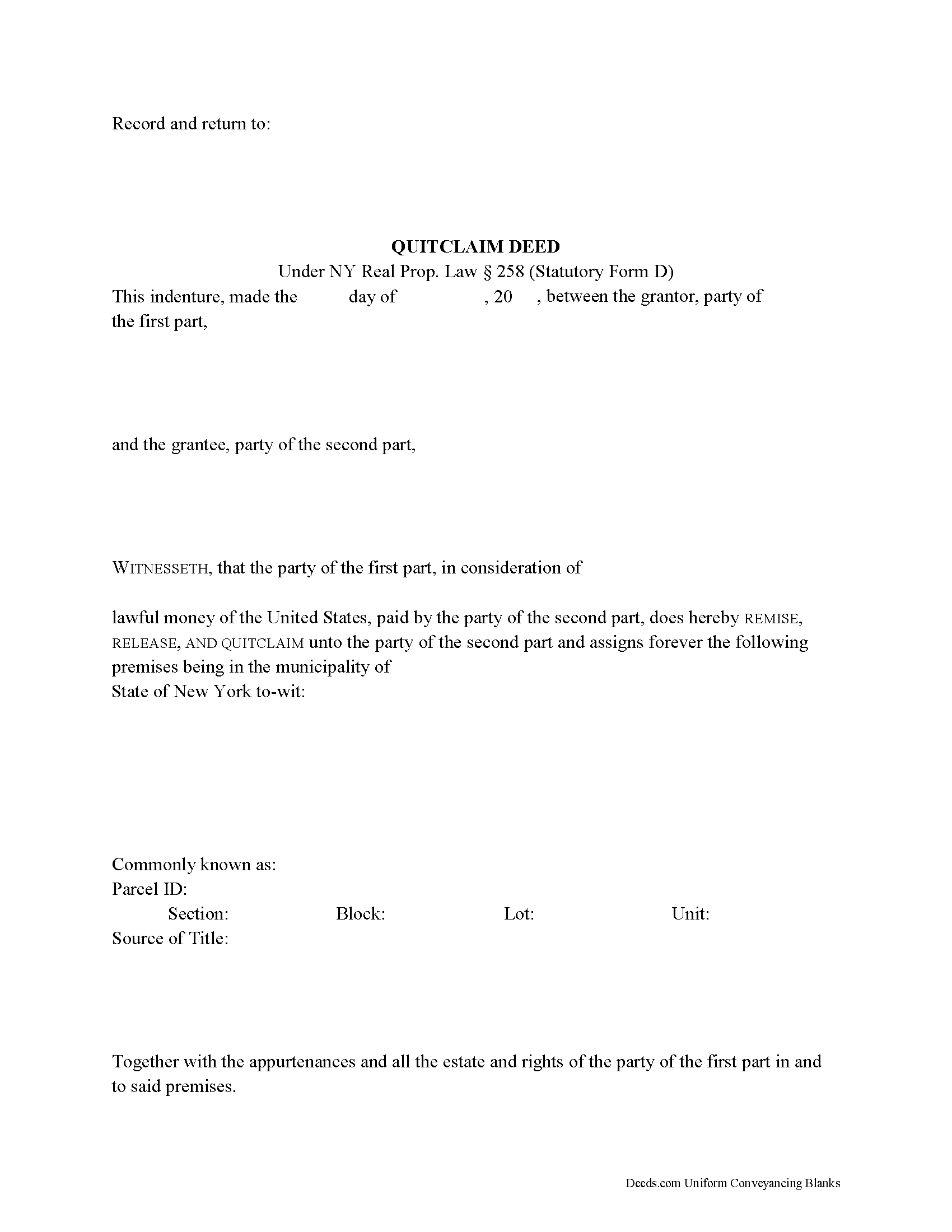
In New York, interest to real property can be transferred from one party to another by executing a quitclaim deed. Quitclaim deeds are statutory under NY Real Prop. Law Section 258 Statutory Form D.
Quitclaim deeds offer no warranties of title and provide the least amount of protection to the grantee. They do not guarantee that the grantor has good title or ownership of the property and only transfer whatever interest the grantor may have in the property at the time of execution. They are generally reserved for divorces and other transfers of property between family members.
Quitclaim deeds offer less assurance than bargain and sale deeds, which convey whatever interest the grantor holds at the time of execution, sometimes with the promise that the grantor "has not done or suffered anything whereby the said premises have been incumbered in any way whatever" (NY Real Prop. Law Section 258 (Statutory Form C)). Bargain and sale deeds without covenant against grantor do not guarantee that the property conveyed is without encumbrances made by the grantor, but they do imply that the grantor held or holds an interest in the property being conveyed.
A lawful quitclaim deed must ... More Information about the New York Quitclaim Deed
Gift Deed
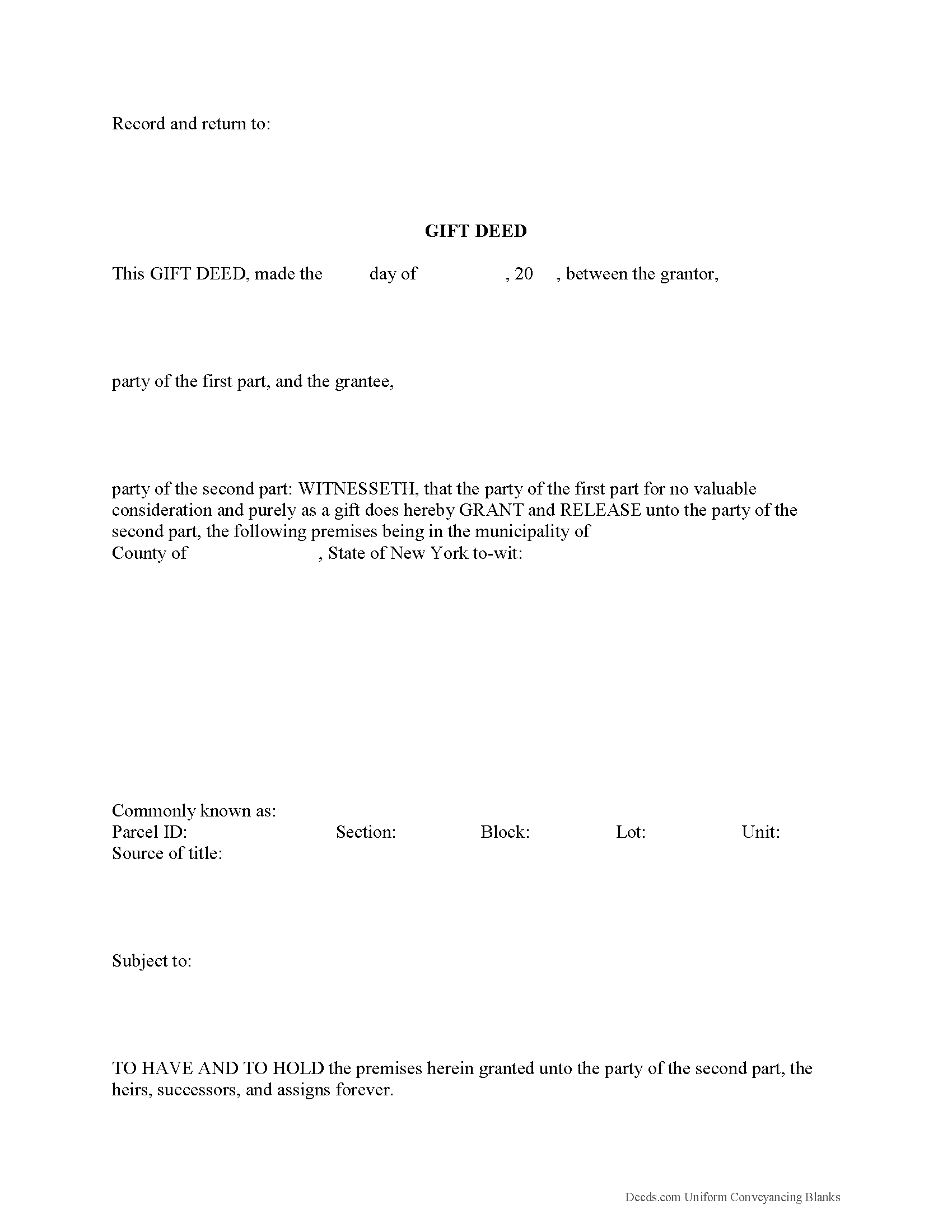
Gifting Real Estate in New York
A gift deed, or deed of gift, is a legal document voluntarily transferring title to real property from one party (the grantor or donor) to another (the grantee or donee). A gift deed typically transfers real property between family or close friends. Gift deeds are also used to donate to a non-profit organization or charity. The deed serves as proof that the transfer is indeed a gift and without consideration (any conditions or form of compensation).
Valid deeds must meet the following requirements: The grantor must intend to make a present gift of the property, the grantor must deliver the property to the grantee, and the grantee must accept the gift. Gift deeds must contain language that explicitly states no consideration is expected or required, because any ambiguity or reference to consideration can make the deed contestable in court. A promise to transfer ownership in the future is not a gift, and any deed that does not immediately transfer the interest in the property, or meet any of the aforementioned requirements, can be revoked [1].
A lawful gift deed includes the grantor's full name and marital status, as well as the grantee's ful... More Information about the New York Gift Deed
Warranty Deed
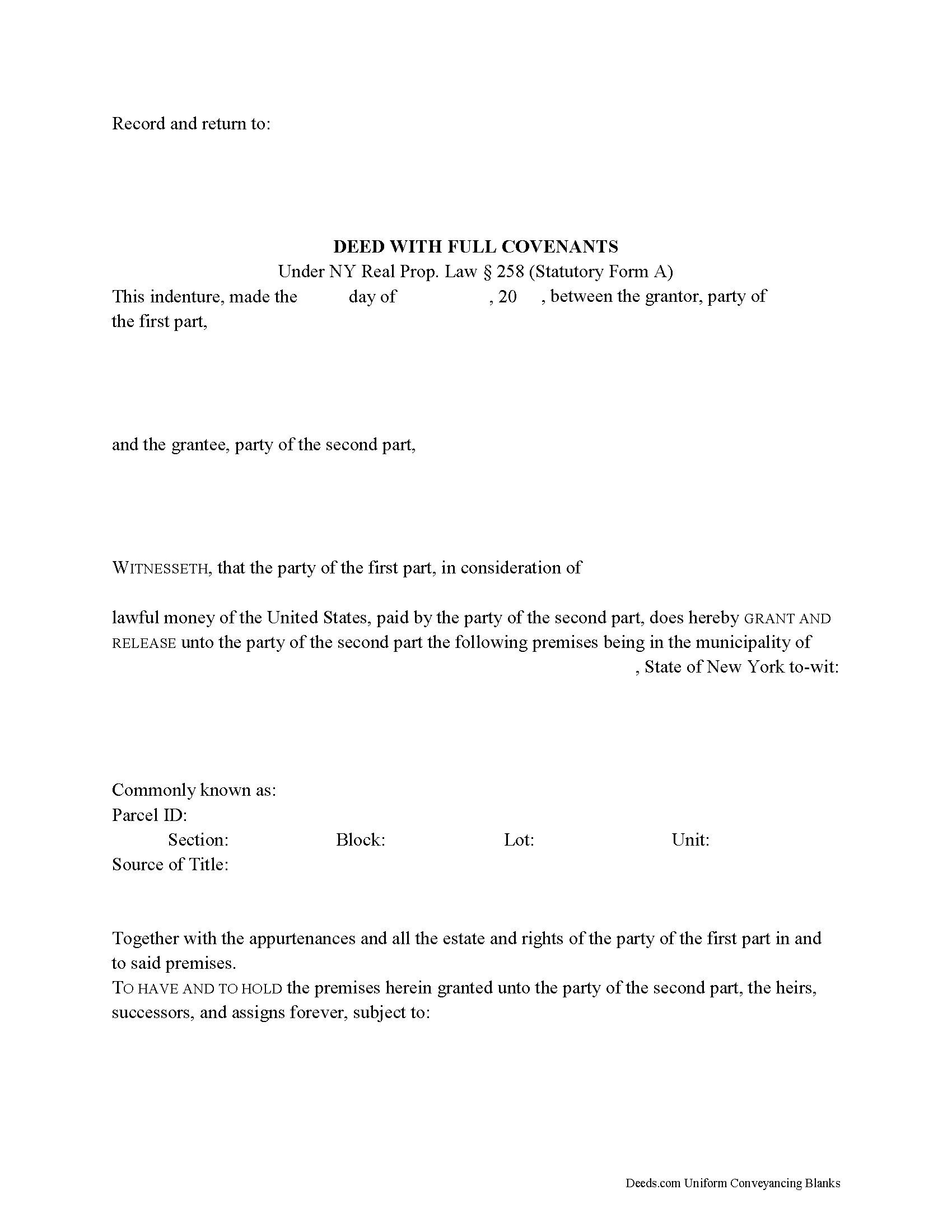
New York Deed with Full Covenants
In New York, title to real property can be transferred from one party to another by executing a deed with full covenants. A deed with full covenants conveys fee simple interest in real property to the named grantee with the greatest assurance of title.
Deeds with full covenants are statutory under NY Real Prop. Law Section 258 Statutory Form A. This form includes specific covenants that the grantor holds title to the property and has good right to convey it; that the grantee "shall quietly enjoy the said premises," which means that the grantee has the right to use and enjoy the property without disturbance from claimants; that the property is free from encumbrances (with the exception of any noted in the deed); that the grantor will "execute or procure any further necessary assurance of the title"; and that the grantor will defend the title against all lawful claimants (NY Real Prop. Law Section 258 (Statutory Form A)).
A deed with full covenants offers the highest protection to the grantee (buyer), covering the entire ownership history, even preceding the time the grantor obtained title. This warranty is greater than that of a bargain and... More Information about the New York Warranty Deed
Special Warranty Deed
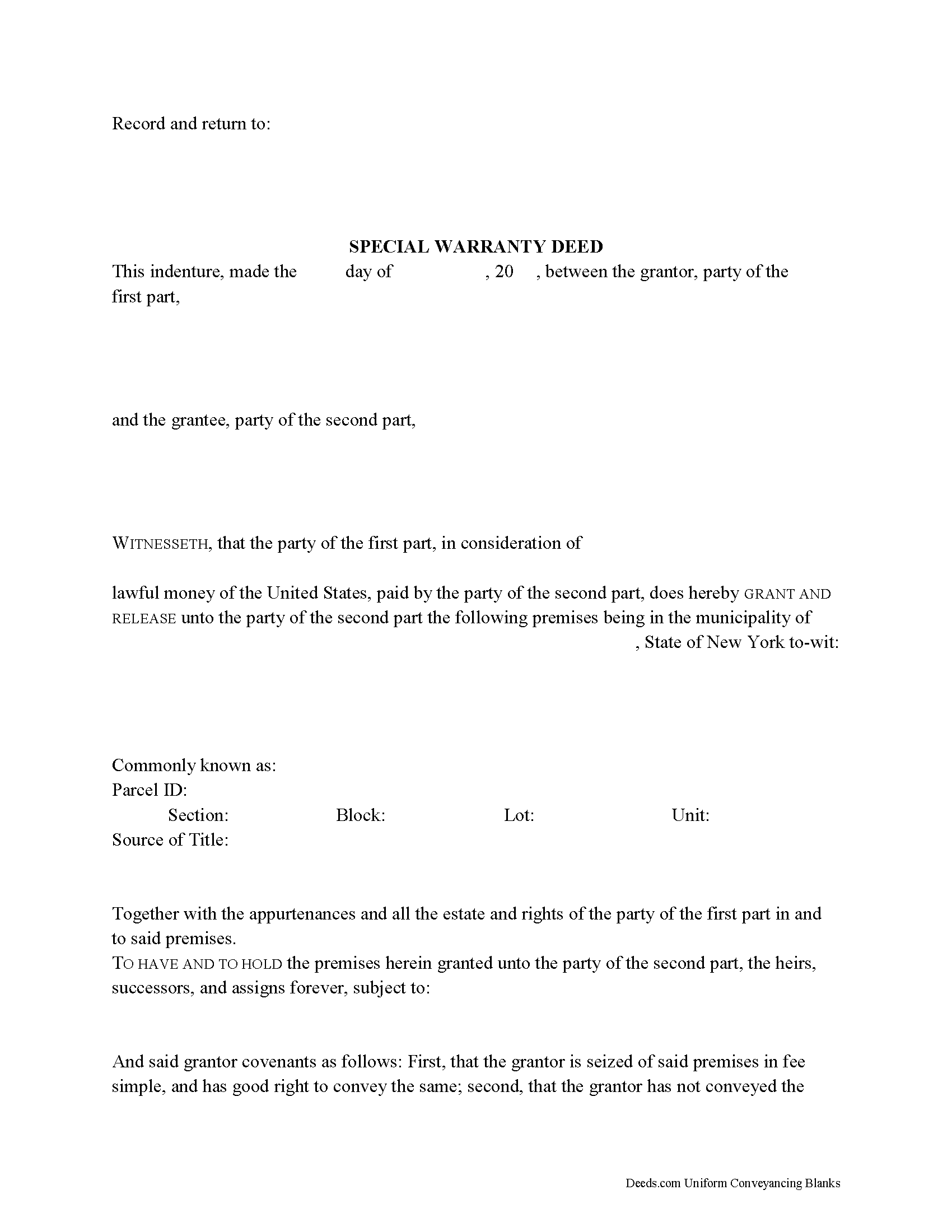
In New York, interest to real property can be transferred from one party to another by executing a special warranty deed. Special warranty deeds convey an interest in real property to the named grantee with limited warranties of title, but they are not statutory forms in New York.
Special warranty deeds contain covenants that the grantor holds title to the property and has good right to convey it; that the grantor has not conveyed the property to another party; that the property is free from encumbrances that arose during the time that the grantor held title to the property (with the exception of any noted in the deed); and that the grantor will defend the title against anyone who may lawfully claim the same by, through, or under them. These covenants should be explicit in the instrument of conveyance. Basically, a special warranty deed guarantees the title against defects arising only during the period the grantor holds title, and does not extend to the property's entire ownership history.
A lawful special warranty deed meets all state and local standards for recorded documents, including the grantor's full name, mailing address, and marital status; the consideration given f... More Information about the New York Special Warranty Deed
Bargain and Sale Deed with Covenants
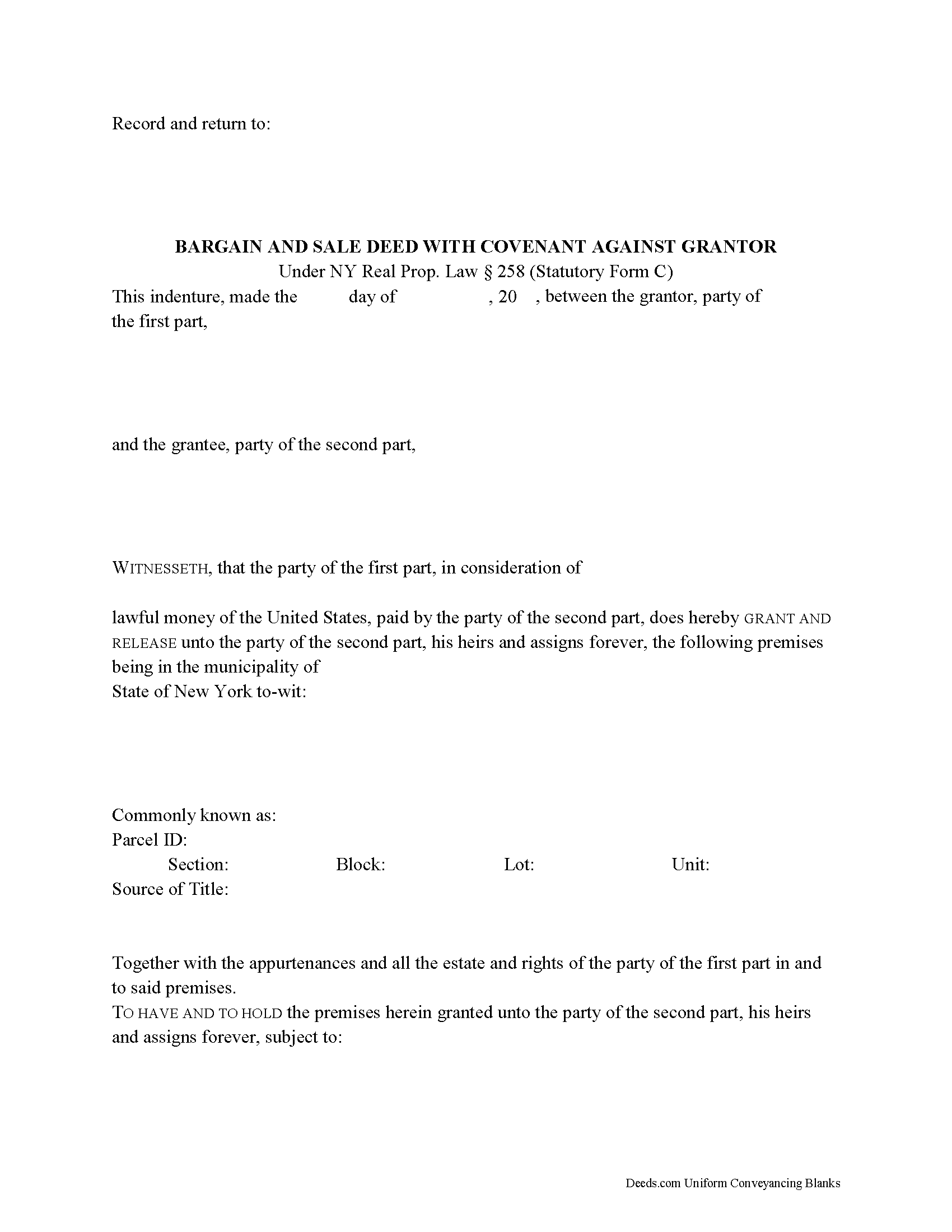
New York Bargain and Sale Deeds with Covenant Against Grantor
In New York, title to real property can be transferred from one party to another by executing a bargain and sale deed with covenant against grantor. This type of deed is statutory under NY Real Prop. Law Section 258 Statutory Form C.
A bargain and sale deed with covenant conveys whatever interest the grantor holds in the property at the time of execution, with the promise that the grantor "has not done or suffered anything whereby the said premises have been incumbered in any way whatever" (NY Real Prop. Law Section 258 (Statutory Form C)).
There are two types of bargain and sale deeds in New York. One type contains a specific covenant against grantor's acts, while the other does not. Bargain and sale deeds with covenant provide more surety because they guarantee that the property conveyed is without encumbrances made by the grantor. Bargain and sale deeds provide less surety than a deed with full covenants (Statutory Form A), which offers the fullest surety of title because its warranty covers the entire ownership history, even preceding the time the grantor obtained title.
A lawful bargain and sale deed ... More Information about the New York Bargain and Sale Deed with Covenants
Bargain and Sale Deed Without Covenants
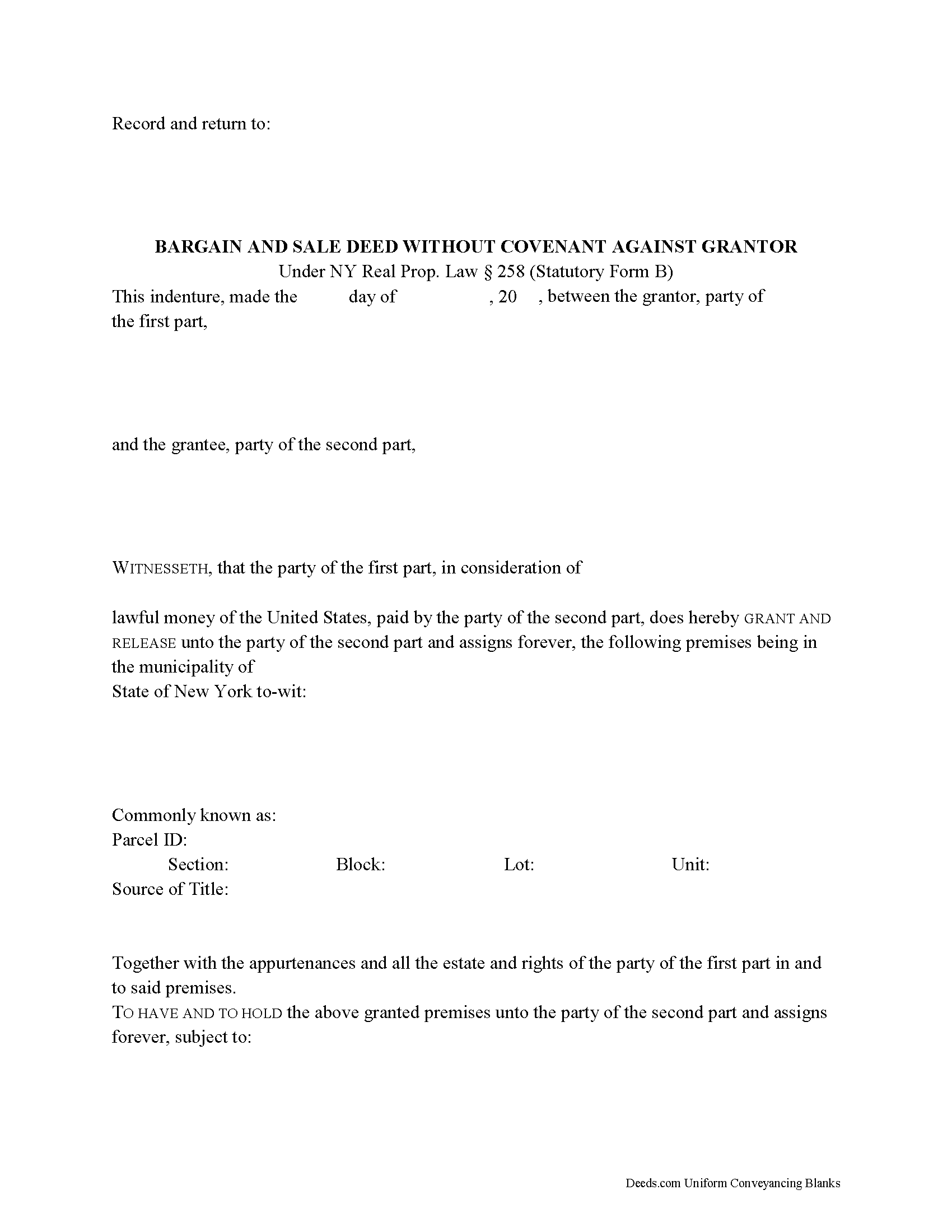
In New York, title to real property can be transferred from one party to another by executing a bargain and sale deed without covenant against grantor. This type of deed is statutory under NY Real Prop. Law Section 258 Statutory Form B. A bargain and sale deed without covenant conveys whatever interest the grantor holds in the property at the time of execution (NY Real Prop. Law Section 258 (Statutory Form B)).
There are two types of bargain and sale deeds in New York. One type contains a specific covenant against grantor's acts, while the other does not. Bargain and sale deeds without covenant do not guarantee that the property conveyed is without encumbrances made by the grantor. Bargain and sale deeds provide less surety than a deed with full covenants (Statutory Form A), which offers the fullest surety of title because its warranty covers the entire chain of title, even preceding the time the grantor owned the property. Bargain and sale deeds differ from quitclaim deeds in that they imply that the grantor held or holds an interest in the property being conveyed.
A lawful bargain and sale deed without covenant meets all state and local standards for recorded documents, in... More Information about the New York Bargain and Sale Deed Without Covenants
Easement Deed
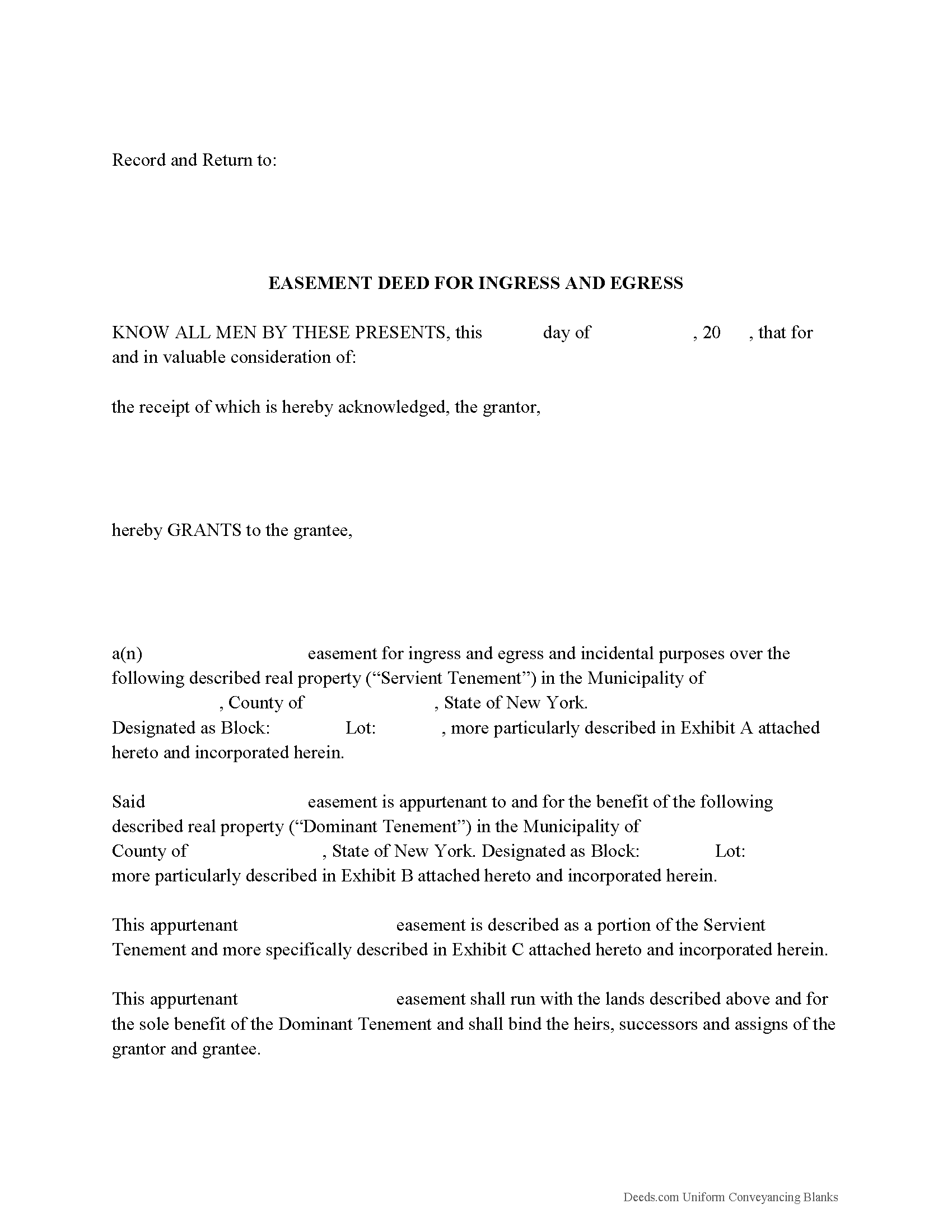
An easement allows one person to use another person's property for a specific purpose. In New York, easements are created for many different reasons. The easement deed is the specific instrument that creates this right. An easement can be either appurtenant or in gross. An appurtenant easement benefits the dominant estate and runs with the land, while an easement in gross benefits an individual or a legal entity. An express easement is an interest in real property that is created by deed, contract, or other instrument in writing.
When obtaining an easement for the purpose of exposure of a solar energy device, the instrument should be created in writing and will be subject to the same conveyancing and recording requirements as other easements in this state ( 335-b).
As an interest in real property, an easement deed must be signed and acknowledged by the grantor, and certified according to law. Acknowledgments must be made by the grantor (292). If acknowledged within the state of New York, an easement deed can be acknowledged before a justice of the Supreme Court, an official examiner of title, or a notary public. Acknowledgments can also be made before any of the officers list... More Information about the New York Easement Deed
Termination of Easement
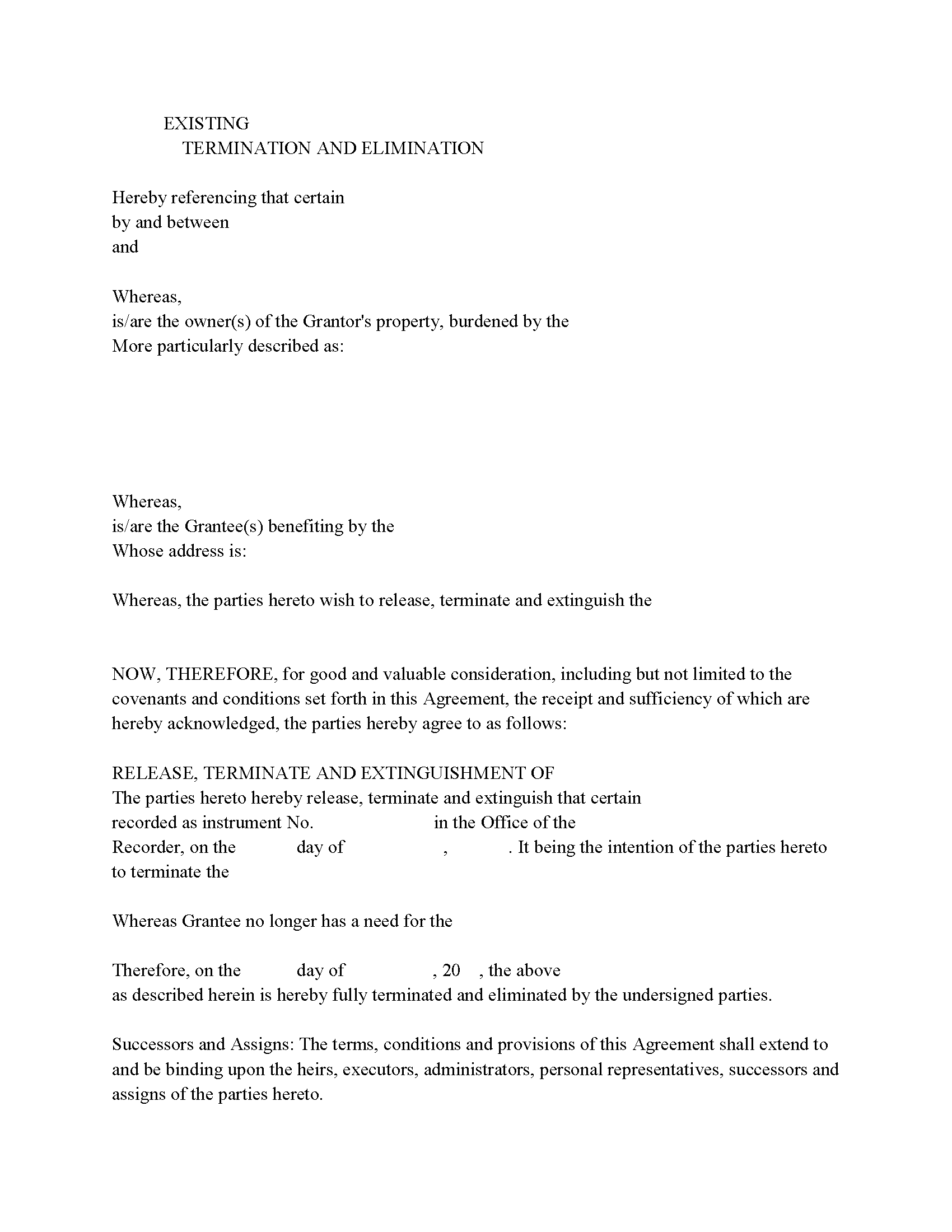
Use this form to release, terminate, extinguish a previously recorded document that involves access to and from a property.
Documents such as:
1. Easement Deeds or Agreements (An easement is a non-possessory interest in land, granting the right to use someone else's property for a specific purpose, like a driveway or utility line)
2. Access Roads
3. Right of Ways
4. Utility Easements (Power, Gas, Water, Sewer, Etc.)
5. Drainage Easements
This document allows the owner of the land, burdened by the access and the party that benefits from the access, to sign an agreement releasing the property from such access, ... More Information about the New York Termination of Easement
Executor Deed
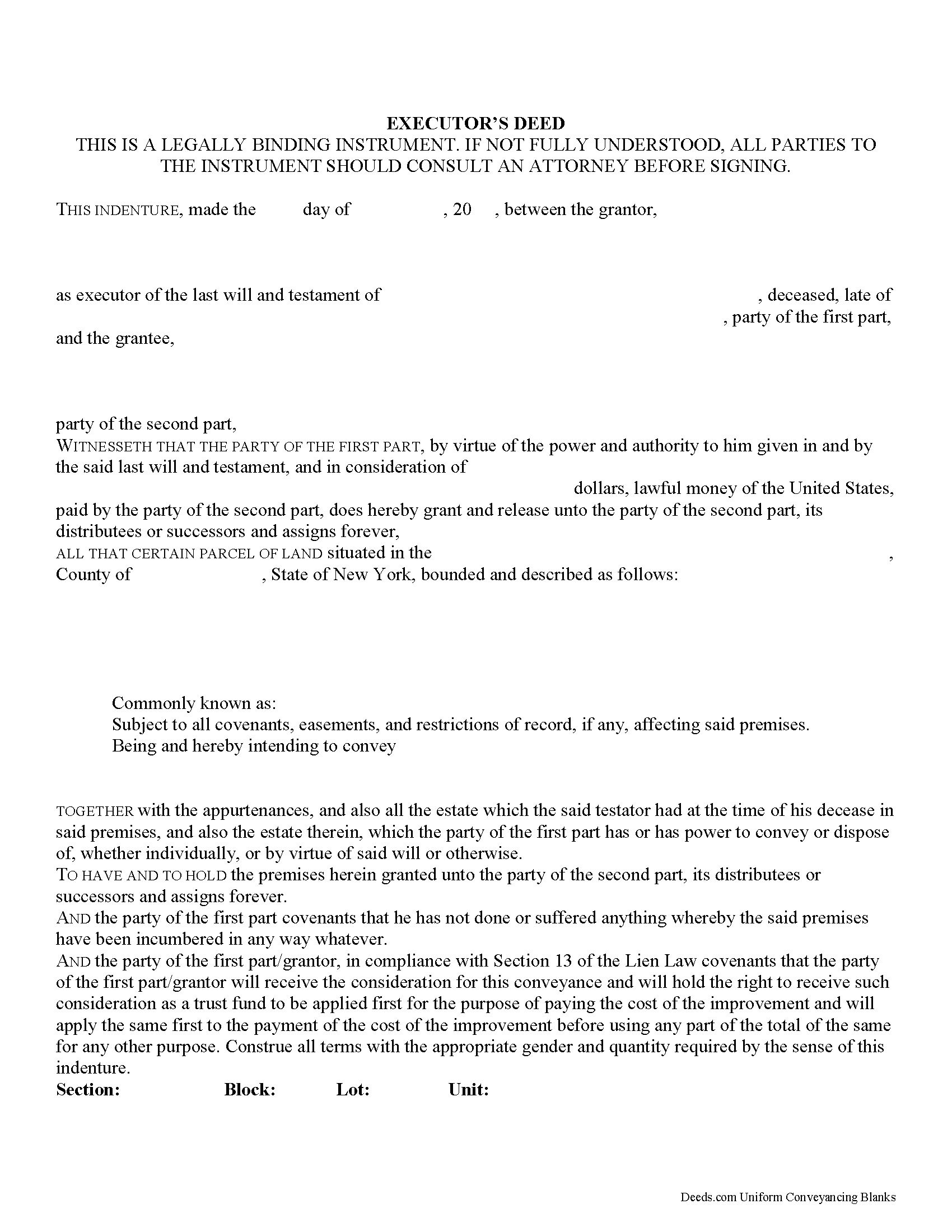
Transferring New York Real Property with an Executor's Deed
Executor's deeds are used to transfer title to real property whose owner died testate (with a last will and testament.)
The executor is someone named to carry out the provisions contained within in a deceased individual's will. After the will is admitted to probate in the Surrogate's Court, the surrogate (the judge managing the case) authorizes the executor to begin his/her duties. Frequently, these include using an executor's deed to sell the decedent's real estate.
Executor's deeds contain the same information as warranty or quitclaim deeds, but they also include details about the executor and the deceased owner. The executor's signature must be notarized, but some cases may require a witness to sign the deed in front of the notary, too. Note that at sections 309-a and 309-b, New York's Real Property Law (RPP) sets out specific notary statements based on whether the deed is signed inside or outside the state.
In addition to the standard state and local forms that accompany deeds submitted for recording, executors might also need to attach letters testamentary from the Surrogate's Court, certified copies of t... More Information about the New York Executor Deed
Administrator Deed
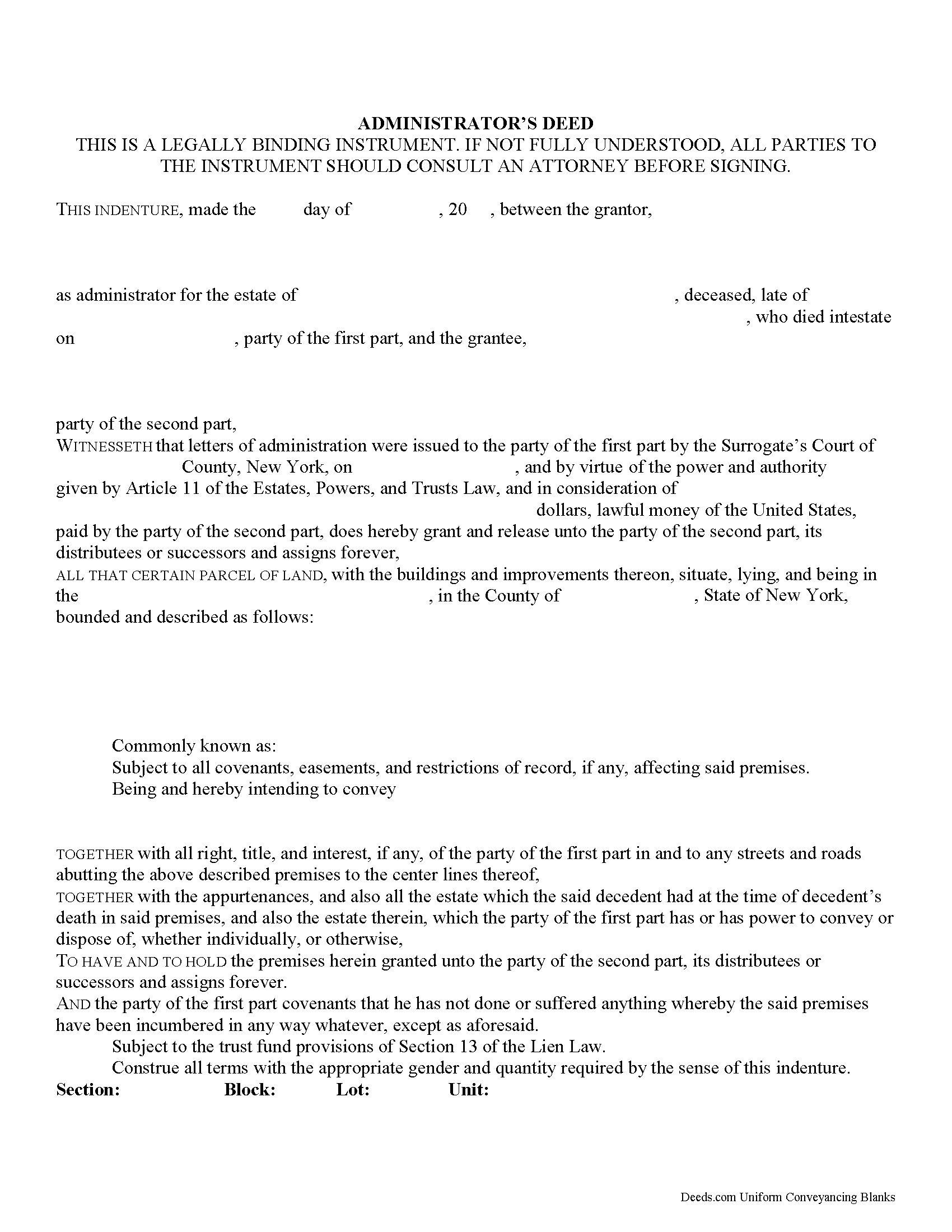
Transferring New York Real Property with an Administrator's Deed
Administrator's deeds are used to transfer title to real property when the owner died intestate (without a last will and testament).
The Surrogate's Court appoints an administrator to distribute the deceased individual's estate according to the rules set out in section 4-1.1of New York's Estates, Powers, and Trusts Law (EPT). The surrogate (the judge managing the case) issues documents called letters of administration, authorizing the administrator to begin his/her duties. If the estate includes real property, those duties could include using an administrator's deed to sell it.
Administrator's deeds contain the same information as warranty or quitclaim deeds, but they also include details about the administrator and the deceased owner. The administrator acts as the grantor on the deed, and his/her signature must be notarized. Some cases may require a witness to sign the deed in front of the notary, too. Note that at sections 309-a and 309-b, New York's Real Property Law (RPP) sets out specific notary statements based on whether the deed is signed inside or outside the state.
In addition to the standard st... More Information about the New York Administrator Deed
Correction Deed
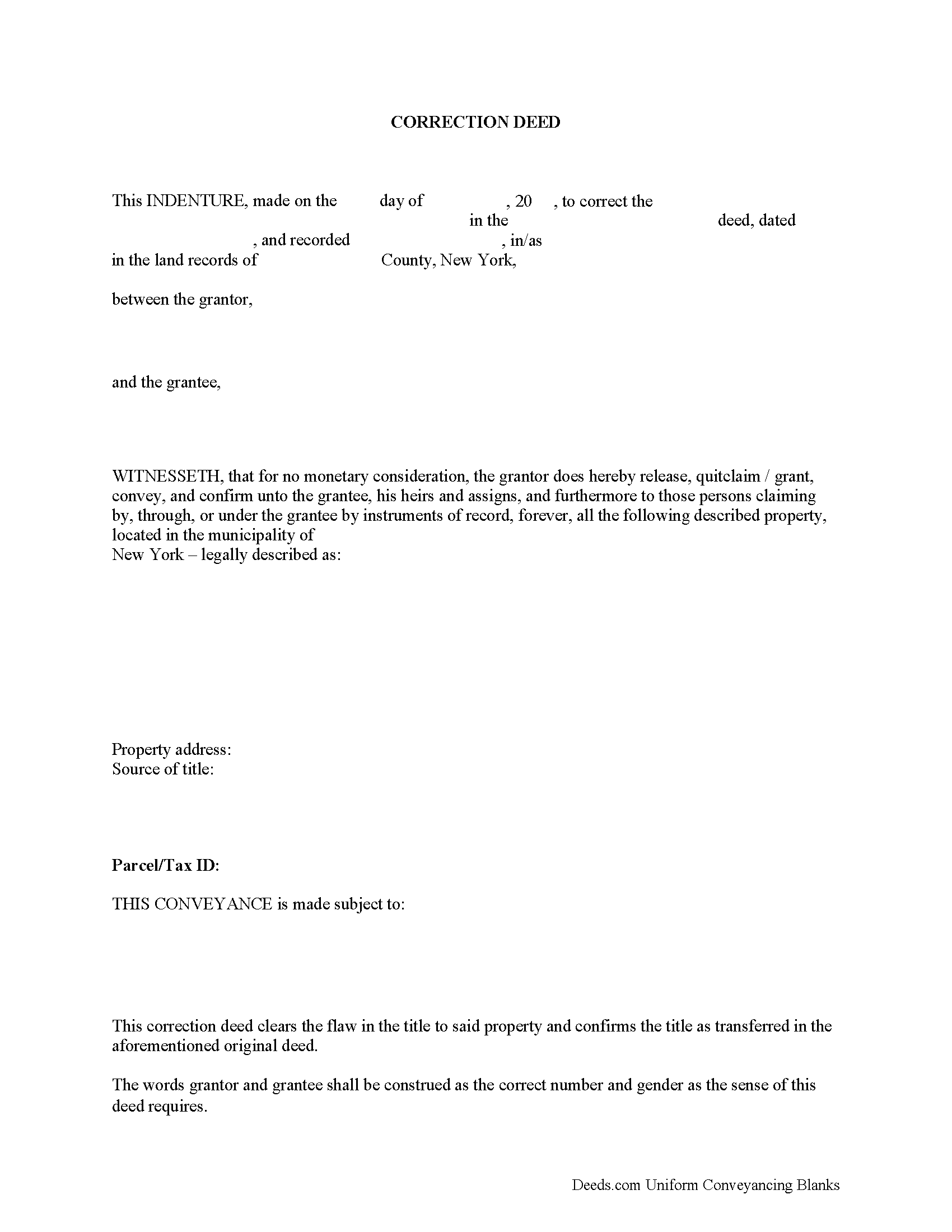
Correction deeds are sometimes called confirmatory instruments. As such, they confirm and perfect an existing title created earlier and remove any defects from it, but they do not pass title on their own. They make explicit reference to the instrument that is being corrected by indicating its execution and recording date, the place of recording and the number under which the document is filed. They also need to identify the error or errors by type before supplying the correction in the subsequent body of the deed.
A new real property transfer report, RP-5217-pdf (or RP-5217NYC), with original signatures must accompany all deeds in New York, including correction deeds; the same goes for the tax affidavit TP-584, which both seller and buyer must sign. Forms are available at the county recording office or can be ordered online (but not downloaded). As a correction, the transaction may be exempt from transfer tax. Be sure to include proof that the transfer tax was paid, either by including the original cover page of the prior deed, or by providing an affidavit stating that transfer tax was paid with the prior document.
Furthermore, counties often require a cover page, which may ... More Information about the New York Correction Deed
Contract for Deed
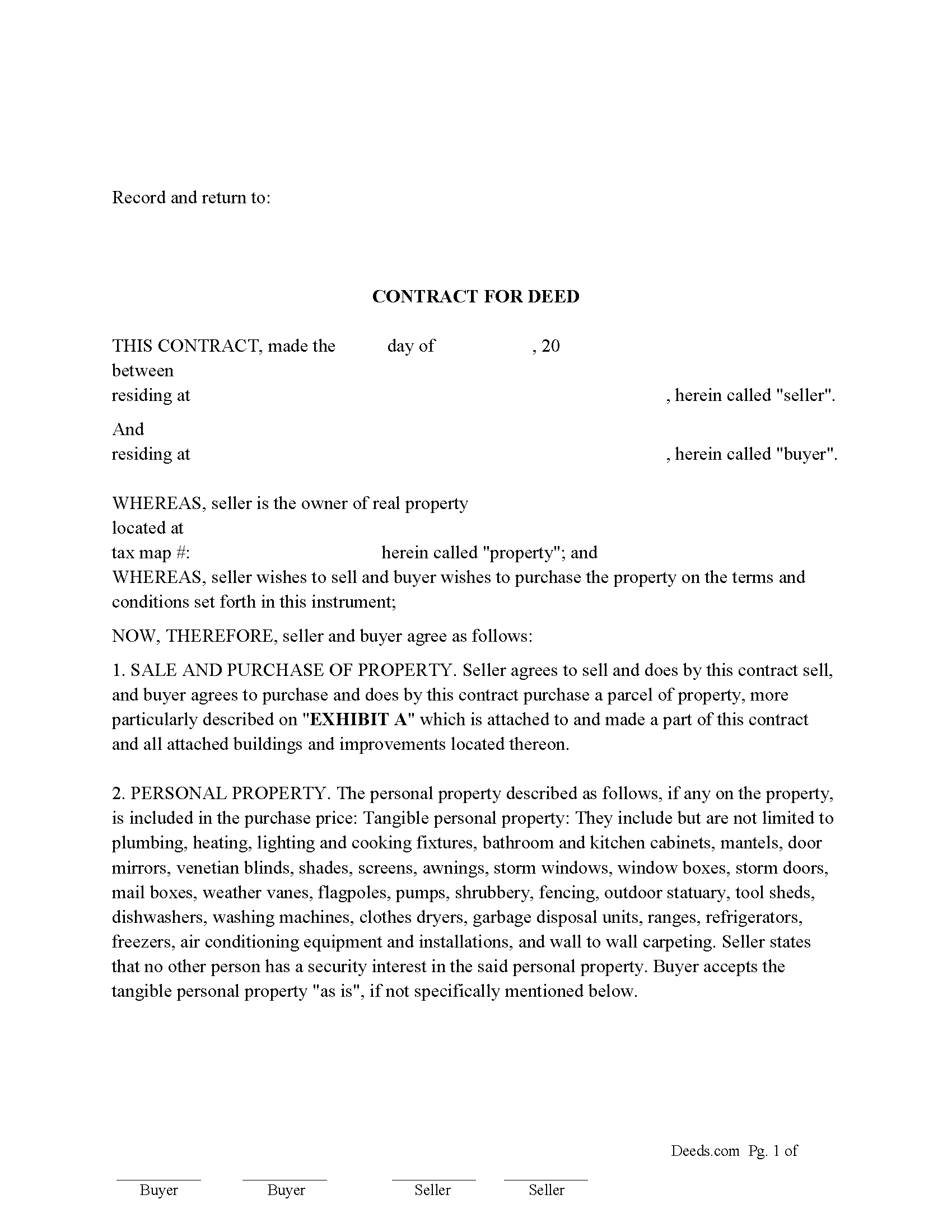
Contract for Deed often referred to as a Land Contract
Use this form for an Owner Financed Sale. This is an 8-page form adaptable to a multitude of situations, a general synopsis; Seller(s) and buyer(s) set their terms and conditions and once the property is paid in full, seller will provide clean title to said property. Financing with Installment payments (Example: $$$$ a month for 10 years), or balloon payment. (Example: Three years of payments with a balance of $$$) owed on this maturity date. Late fees are set by so much owed after so many days with an additional amount owed each and every day thereafter. If this Note is not paid in full at the Maturity Date, Borrowers shall pay to Lender an Overdue Loan Fee, (a) one percent (1.0%) of such principal balance if the Note is paid in full on or after thirty (30) days after the Maturity Date but less than sixty (60) days after the Maturity Date, or
(b) two percent (2.0%) of such principal balance if the Note is paid in full on or after sixty (60) days after the Maturity Date.
BUYER DEFAULT. Buyer is in default upon the occurrence of any of the following:
a. The monthly payment, and any applicable late charge, is not made withi... More Information about the New York Contract for Deed
Mortgage and Promissory Note
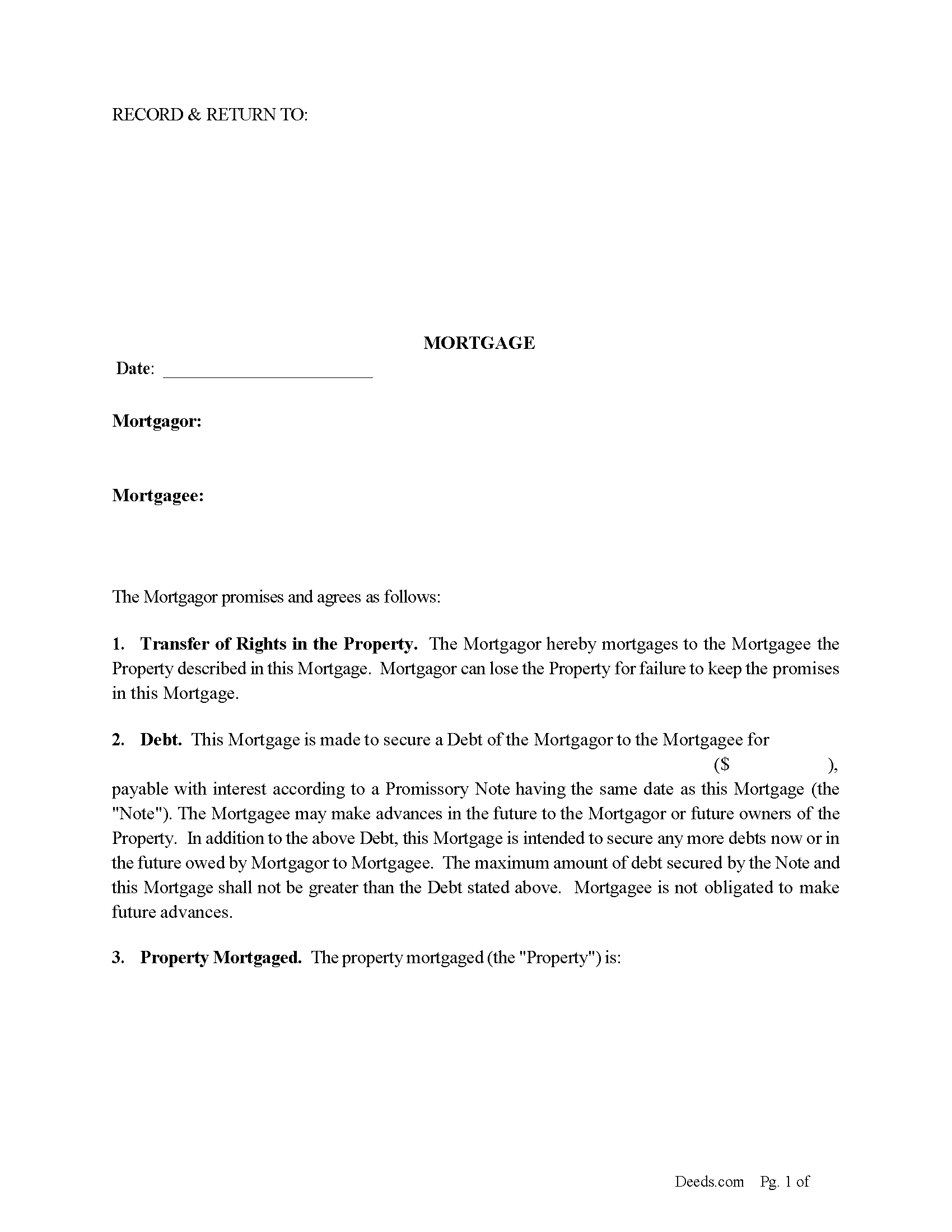
A mortgage is a conveyance of title to property that is given as security for a loan until the grantor (borrower) repays the lender according to terms defined in an attached promissory note. It contains a lien against the security property that ends when the debt is repaid.
Use this form for financing real property- residential, rental units, condominiums, vacant land, small commercial and planned unit developments.
Mortgage covenants
Transfer of Rights in the Property. The Mortgagor hereby mortgages to the Mortgagee the Property described in this Mortgage. Mortgagor can lose the Property for failure to keep the promises in this Mortgage.
Applicable Law. Mortgagee shall have all the rights set forth in Section 254 of the New York Real Property Law in addition to Mortgagee's rights set forth in this Mortgage, even if the rights are different from each other.
Non-Judicial Foreclosure. Mortgagee shall have the power of sale under Article 14 of the Real Property Actions and Proceedings Law, as it may be amended from time to time, a... More Information about the New York Mortgage and Promissory Note
Satisfaction of Mortgage
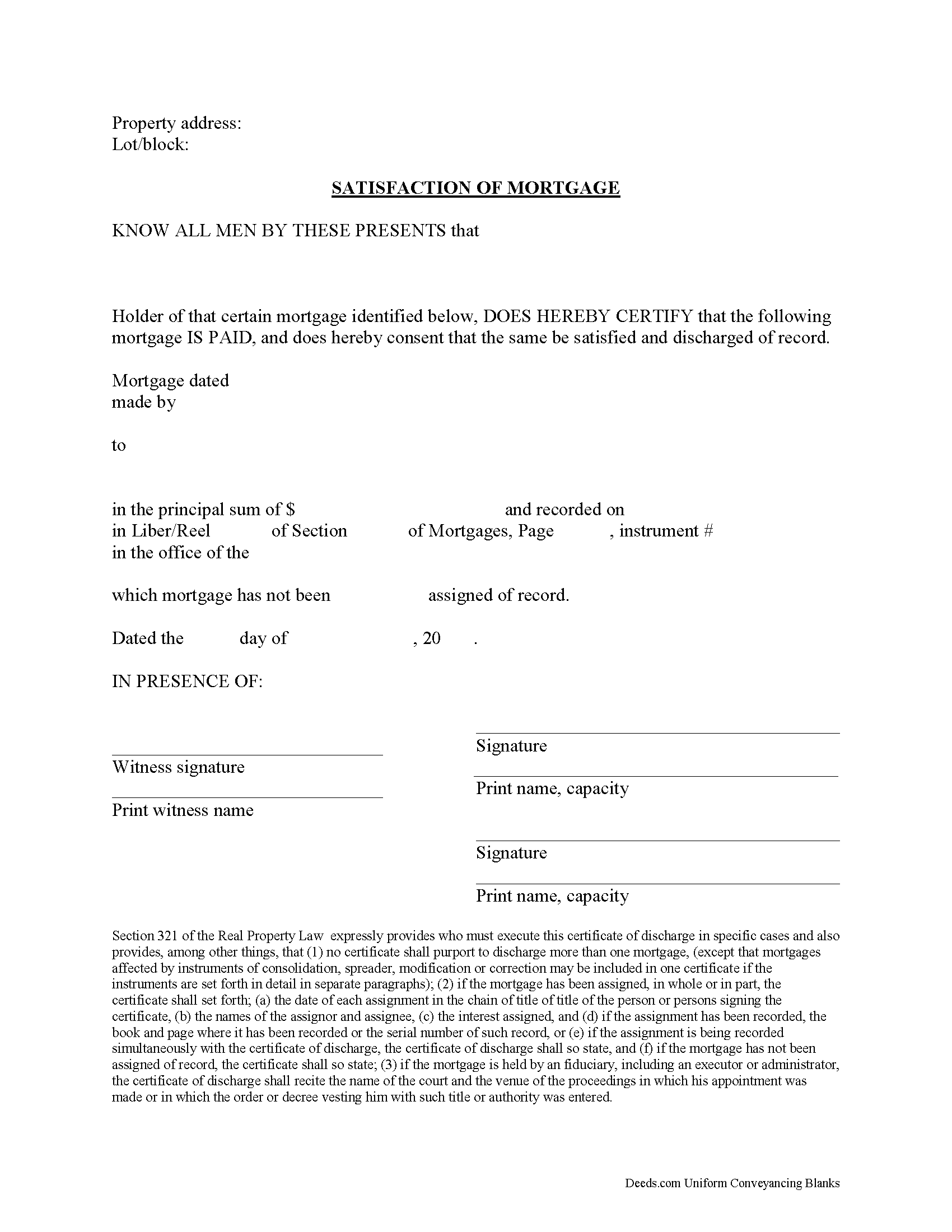
After completing payments on the balance due of a mortgage, the lender completes this satisfaction form. Promptly recording this document in the same county as the original mortgage serves to unencumber (free up) the title to the related real property. Words of conveyance are unnecessary because the property rights were transferred when the borrower and lender signed the mortgage.
(New York SOM Package includes form, guidelines, and completed example)... More Information about the New York Satisfaction of Mortgage
Disclaimer of Interest
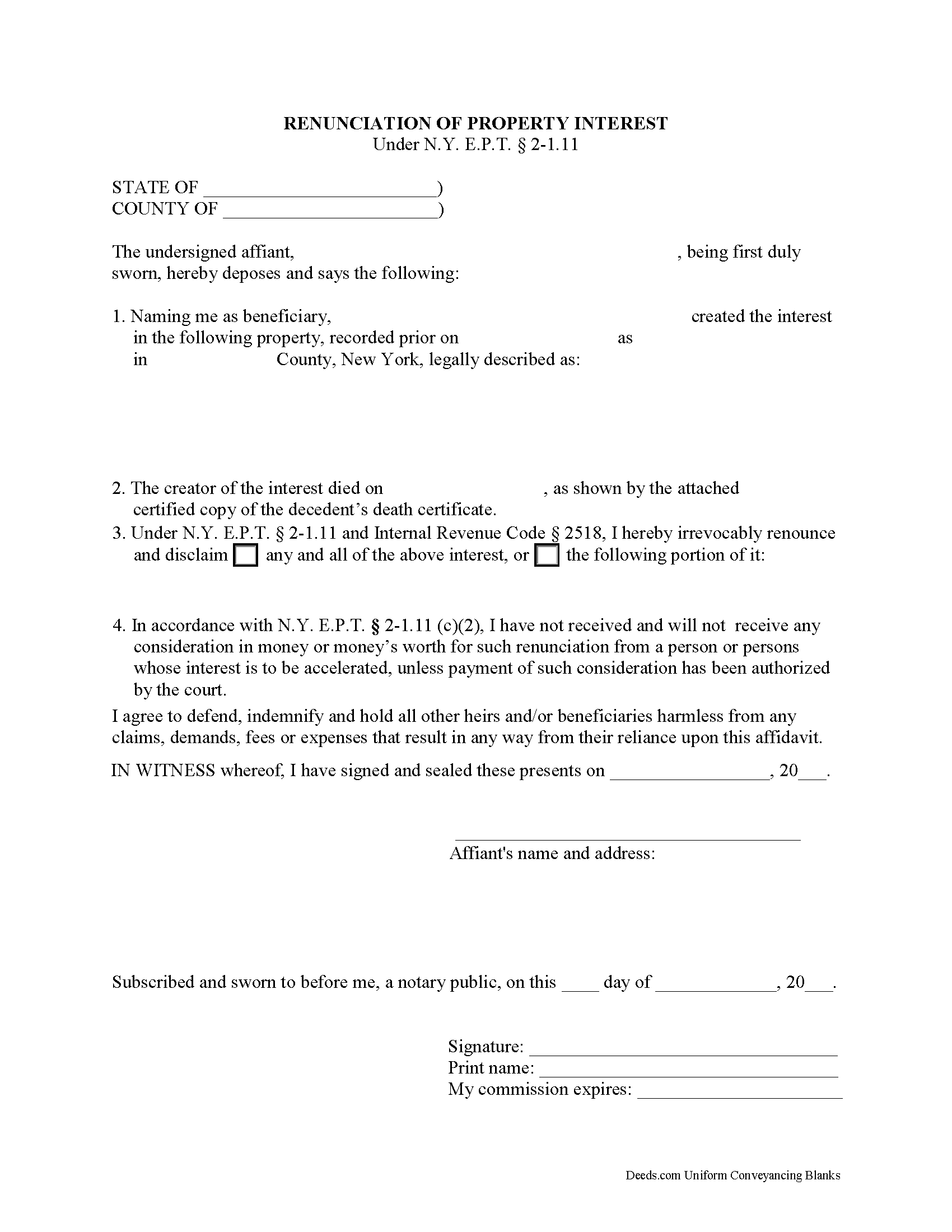
Renouncing Inherited Property in New York
A beneficiary of an interest in property in New York can disclaim a bequeathed asset or power (New York State Code, Estates, Powers, and Trusts, Article 2, 1.11). Such a renunciation, which must be in writing and signed by the beneficiary or a legally authorized representative, allows that beneficiary to disclaim his or her interest in the property, either in full or partially (1.11 (c) (1), 1.11 (f)).
The renunciation is only valid if the beneficiary has not indicated acceptance of the property, for example, through transfer or encumbrance, acceptance of any payment, or other actions (1.11 (g)). It must be acknowledged by a notary and accompanied by an affidavit stating that the beneficiary is not receiving monetary consideration in exchange for the renunciation (1.11 (c) (2)).
The statutes provide a nine-month window, to be extended at the discretion of the court, during which the beneficiary must file the renunciation document with the surrogate court in the county where the will or estate is being administered. The document must also be delivered to the fiduciary or administrator of the estate, or to the person holding legal... More Information about the New York Disclaimer of Interest
Memorandum of Trust
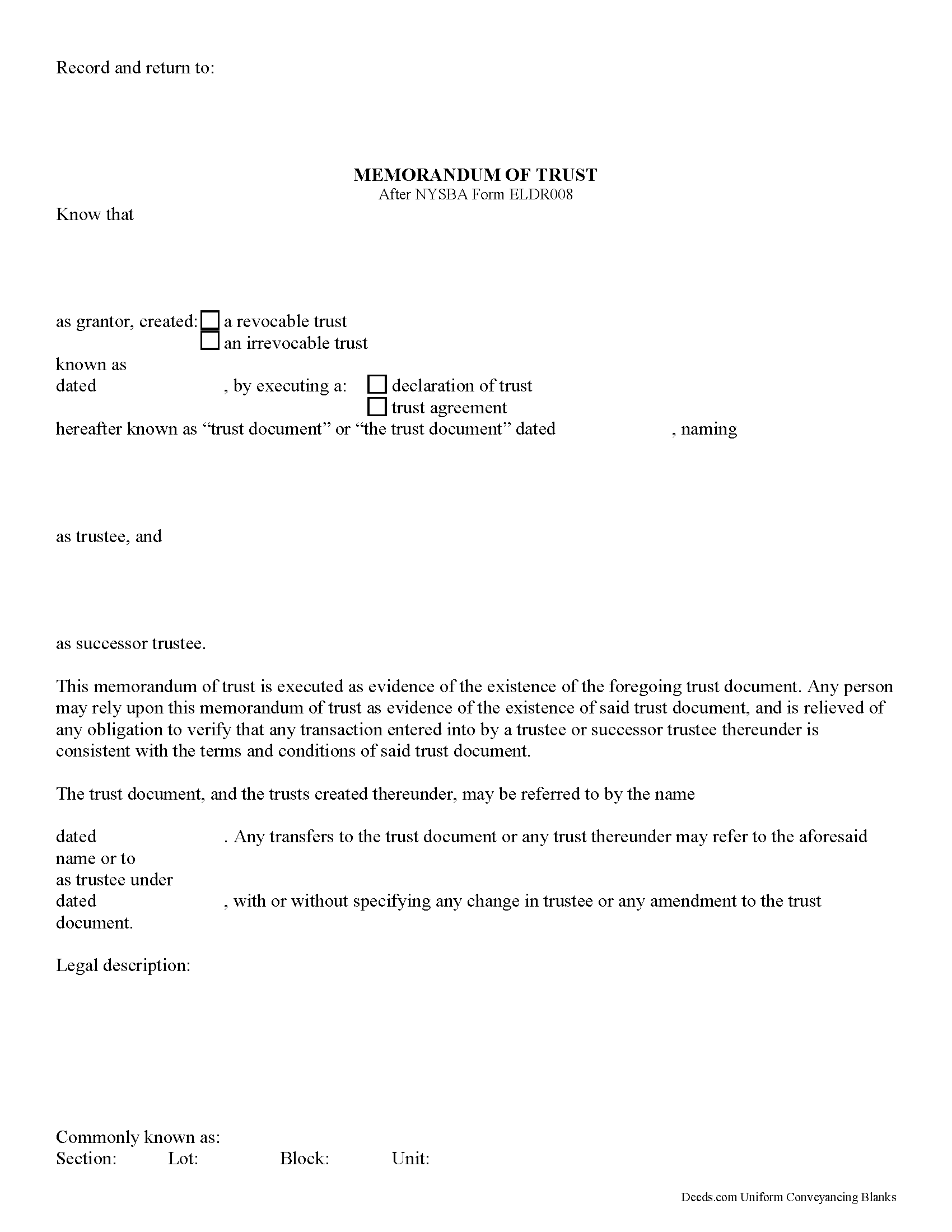
Using a New York Memorandum of Trust
In New York, trustees of personal trusts use a memorandum of trust to certify the existence of a trust and their authority to act on behalf of the trust. The memorandum is used in place of the actual trust document and provides only essential information about the trust for lending institutions or other third parties. In this way, information that may be personal in nature, such as the designated beneficiaries under the trust, is kept confidential.
The memorandum is executed and signed by the grantor of the trust under the trust instrument, as well as the trust's formal name and date of origination. It identifies the trustee and any successor trustees with power to act on behalf of the trust.
The difference between a declaration of trust and a trust agreement, as designated in the memorandum of trust document, is the grantor's relationship to the trustee. If the trustee and the grantor are the same person and the grantor controls trust assets, the trust falls under a declaration of trust. If the grantor and the trustee are separate people and the trustee controls the trust assets, trust is under a trust agreement [1].
The distinctio... More Information about the New York Memorandum of Trust
Notice of Pendency
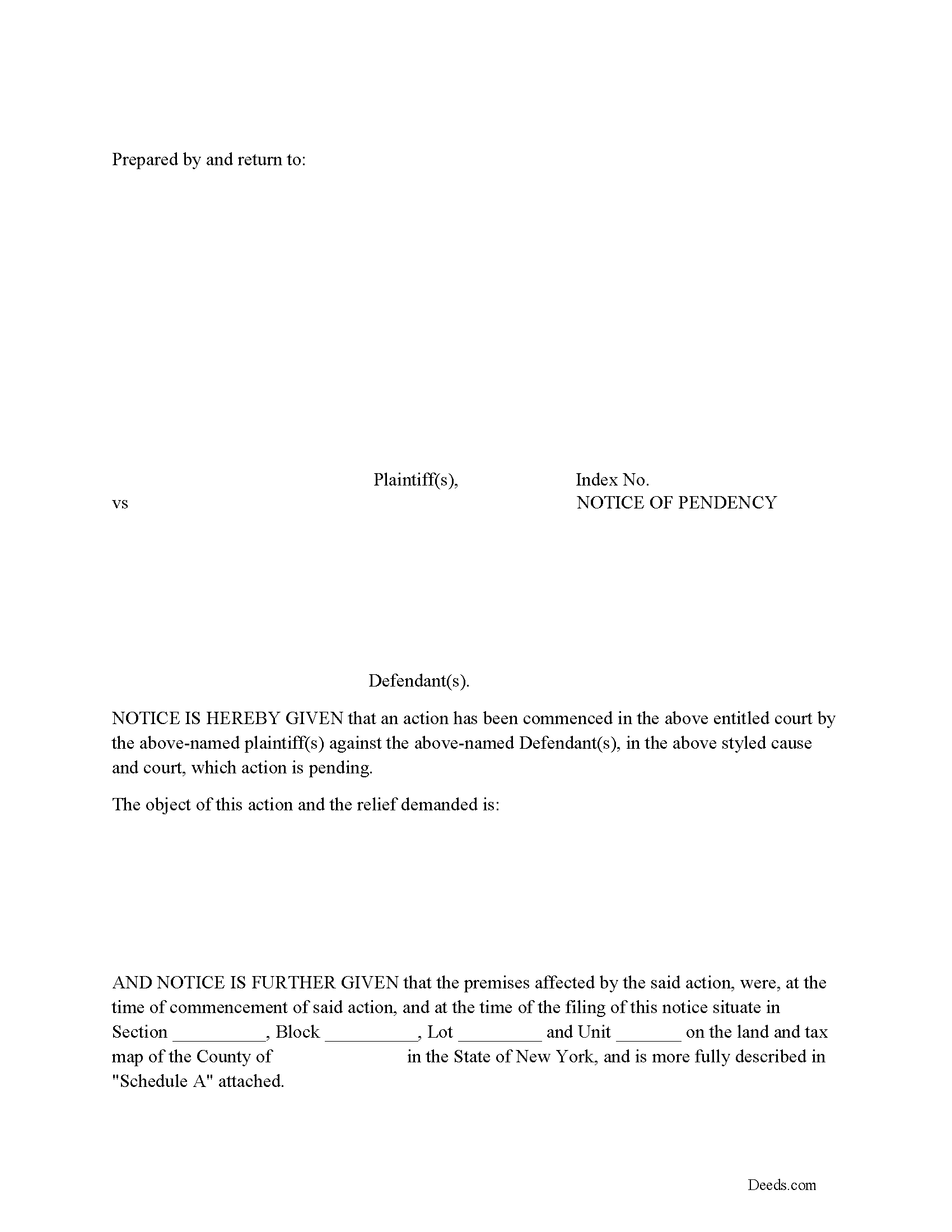
A Notice of Pendency can be filed in action that affects title to real property (or the possession, use or enjoyment of, real property, except in a summary proceeding brought to recover the possession of real property.) The Notice is a powerful tool because it provides constructive notice (from the time of filing of the notice only), that the property is under litigation and would be purchasers and encumbrancers could be held to the outcome of the litigation. Although not a lien a Notice of Pendency in effect acts like a lien. Such Notice of Pendency shall contain:
Names of the parties
Legal description of the affected property
Object of the complaint (Statute 6501.)
This Notice of Pendency has ample space to enter multiple parties
(plaintiffs and defendants)
(New York NOP Package includes form, guidelines, and completed example)
... More Information about the New York Notice of Pendency